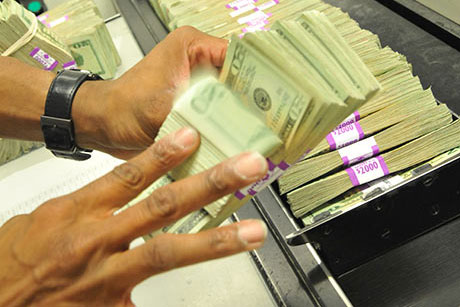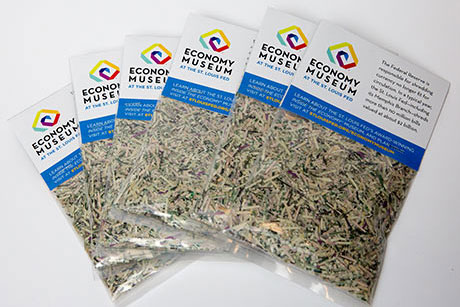What to Do with Ripped, Torn or Damaged Money
Cash. Moolah. Dough. These terms probably elicit images of crisp paper bills or stacks of brand-new bank notes.
But what should you do with old or worn out money—the dollar bills that are torn, covered in graffiti or at the end of their life cycle?
Different fates can befall a bill. There are different processes for handling old money depending on what happened to it. If you’re questioning whether there’s any bang left in your buck, it’s important to know what kind of damage you’re dealing with:
Read on for definitions and what to do in your scenario.
Torn? Worn? Defaced? You might have “unfit” currency

The Federal Reserve has 28 cash offices that help ensure currency is fit for circulation. The St. Louis Fed alone inspected over 949 million notes in 2024.
The Federal Reserve System is responsible for placing U.S. paper bills into circulation. This happens via 28 cash offices—from Boston to Dallas to San Francisco. The Federal Reserve Bank of St. Louis' currency operations are housed at its headquarters and its Memphis Branch.
Just as the Fed is responsible for placing cash into circulation, it also removes unfit currency from circulation. The definition of unfit currency, according to the Federal Reserve System’s Cash Product Office, is a “note that is not suitable for further circulation because of its physical condition” due to being:
- torn
- worn
- limp
- dirty
- defaced
“About 85% of the currency that gets deposited with us is fit,” says a representative with our currency team, serving the Eighth Federal Reserve District. “Torn, worn, limp, dirty, defaced—we call those defects. That’s what our machines look for.”
After a Federal Reserve bank receives cash deposits from commercial banks, highly trained employees can detect unfit cash in two ways:
- via complex, high-speed equipment
- by examining the note firsthand
“For example, if we’re able to determine that the note is torn, depending on to what degree, our machines can determine whether that money can come out of circulation. The machine does the largest percentage of that,” explains our currency expert. “If the machines can’t make a clear determination of how dirty, limp, worn or defaced it is, or if there’s something suspect about the note that the machine cannot ascertain, then it is evaluated by a person,” he says.
What to do with a bill you think could be “unfit”:
The Federal Reserve’s Cash Product Office guide (PDF) gets detailed about what constitutes “unfit,” down to the reflectivity of a note.
If you don’t happen to have a densitometer handy, the Cash Product Office offers this advice: When in doubt, you may seek to exchange dirty or worn out cash at your local commercial bank. As long as more than half of the original note is clearly present—and it doesn’t take special examination to determine the note’s value—a commercial bank can then include the note in its deposit to the Federal Reserve.
What happens to unfit currency?

Get your free bag of “Fed shreds” at our Economy Museum.
Once an unfit note is detected by the Federal Reserve, it is separated from normal circulation.
Unfit notes used to be burned to prevent their reentry into circulation. Now, unfit bills arriving at the St. Louis Fed’s facility downtown are shredded and recycled or turned into compost.
Fun fact: Visitors to the Economy Museum at the Federal Reserve Bank of St. Louis can pick up a complimentary souvenir bag of real shredded currency.
Burned? Deteriorated? You might have “mutilated” money
Mutilated currency refers to a note that has been damaged so badly that 50% or less of it remains, or its condition is such that its value is questionable. It may be missing a watermark or key security features, like a thread or ribbon.
Currency mutilation can occur from fire, misuse, or even deterioration from burying money.
The Federal Reserve does not accept deposits of mutilated currency from banks. In this case, special examination by professionals at the Bureau of Engraving and Printing (BEP) is required before any exchange is made.
What to do if you have a mutilated bill:
If you have a mutilated bill, the St. Louis Fed’s currency representative advises that consumers should directly contact the Bureau of Engraving and Printing. The Bureau offers a step-by-step guide to redeeming mutilated currency, including how to file a mutilated currency claim.
“The BEP will evaluate the note,” our currency rep explains. “They have special tools to examine the authenticity and assess the full value of the note. After they do that, they can issue a check back to the consumer.”
What happens to mutilated currency?
The Bureau of Engraving and Printing is part of the U.S. Treasury Department. Disposal of mutilated money is handled through this agency. The Treasury says that every year, it receives an average of more than 22,000 requests for examination of currency with an estimated value of more than $35 million for possible redemption.
Moldy? Exposed to chemicals? You might have “contaminated” currency
In some cases, money may be exposed to contaminants. The definition of contaminated currency is a note that has been damaged by, or exposed to, a contaminant to the extent the note cannot be processed under normal operating procedures—or may pose a health or safety risk.
Paper bills can become contaminated due to:
- prolonged exposure to moisture, resulting in mold
- exposure to sewage or animal waste
- exposure to a chemical, liquid or foreign substance that may pose a health hazard or safety risk
For example, the St. Louis Fed’s currency expert says that floods can lead to unknown contaminants being introduced into floodwater, which could contaminate currency and call for special handling.
What to do if you have contaminated currency:
If you believe that your currency is contaminated, you may be able to deposit it at a commercial bank. The St. Louis Federal Reserve Bank’s currency representative advises that you provide as much information as possible about what happened to the note(s). You can consult with your local commercial bank branch for further instructions.
The Federal Reserve has detailed guidelines for banks on how to handle and package contaminated currency.
What happens to contaminated currency?
Due to potential health and safety risks, contaminated currency is not recycled. Our currency representative says it is disposed of safely.
How long does a United States dollar bill typically last in circulation?
Made of 75% cotton and 25% linen, U.S. paper notes are designed to withstand a lot of use. How long a piece of money stays in circulation often depends on the value of the note.
Here is the average lifespan of currency in the United States.
| Denomination | Estimated Lifespan | How Many Are in Circulation? |
|---|---|---|
| $1 | 7.2 years | 14.9 billion |
| $5 | 5.8 years | 3.7 billion |
| $10 | 5.7 years | 2.4 billion |
| $20 | 11.1 years | 11.1 billion |
| $50 | 14.9 years | 2.5 billion |
| $100 | 24.0 years | 19.2 billion |
| NOTES: Estimated lifespans as of May 2025. Yearly circulation volume updated as of 2024. | ||
| SOURCES: Federal Reserve Board, “How Long Is the Lifespan of U.S. Paper Money?”; and FRED release table, Volume of Currency in Circulation by Denomination. | ||
Notice the varying years for each denomination of currency. So, why is the average lifespan of a $5 or $10 bill so much shorter than that of a $100 bill?
According to the Federal Reserve Board of Governors: “Larger denominations such as $100 notes are often used as a store of value, which means they pass between users less frequently than lower-denominations such as $5 notes, which are more often used for transactions.”
Access to clean, safe cash
Access to clean, safe cash is vital during hurricanes, floods, tornadoes—and even after tragedies like the attacks on Sept. 11, 2001.
After Hurricane Katrina, power outages that affected a wide area of the Gulf Coast meant no access to ATMs and no ability to use credit cards or process checks. The importance of cash is vital in situations like these. Having Federal Reserve System cash offices across the country helps money move to necessary places as quickly as possible.
The St. Louis Fed’s Memphis Branch played an important role post-Katrina: “The fact that we were able to provide currency, we kept the economy flowing so that even in a dire situation, people could still get the basic necessities of life,” said Karl Ashman, then-executive vice president at the St. Louis Fed.
This post, originally published Oct. 30, 2019, is regularly updated with new currency data.
More to explore
This blog explains everyday economics and the Fed, while also spotlighting St. Louis Fed people and programs. Views expressed are not necessarily those of the St. Louis Fed or Federal Reserve System.
Email Us


